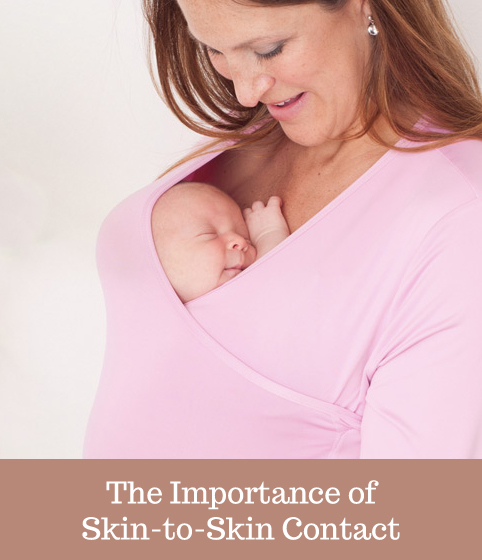The Importance of Skin-To-Skin Contact

You may have heard of the fourth trimester. It's the idea that the first 3 months of life are very much an extension of life in the womb for the baby. While you are adjusting both mentally and physically from pregnancy and birth, your baby is transitioning to life outside of the womb.
Being born is a huge shock to a baby’s systems. Think of all the new things baby has to learn -- and quickly! Baby is now responsible for breathing, eating, working on digestion and elimination, and must sort through all the new sensory adaptations of life outside the womb. One of the best ways to help your baby transition is through the practice of skin-to-skin contact. The rate of preterm babies has increased steadily over the years and the latest research suggests that skin-to-skin contact is essential for these babies, as well as the full term infant. The American Academy of Pediatrics recommends that skin-to-skin be practiced with all babies, as often and as long as possible throughout the fourth trimester (first three months).
The benefits of skin-to-skin contact
Skin-to-skin contact is beneficial for babies and moms (and I recommend dad join in this practice too!).
Benefits for baby: 1) Calms and soothes; 2) Helps regulate body temperature, heart rate, and breathing; 3) Improves baby sleep; 4) Enhances immunity; 5) Accelerates brain development; 6) Encourages breastfeeding behavior.
Benefits for mom: 1) Reduces blood pressure; 2) Quickens postpartum recovery; 3) Reduces the risk of postpartum depression; 4) Promotes feelings of well-being and contentment; 5) Increases milk supply.
The science behind skin-to-skin contact
The amazing benefits of skin-to-skin contact are delivered by nerve stimulation. The C-afferent nerve is centrally and ventrally located from your collarbone to your sternum in all humans. It responds only to pleasing human touch. When you hold your baby skin-to-skin, these nerves send a message to the brain to produce a bunch of hormones. It's said hormones surging through your bodies that are responsible for the amazing benefits of skin-to-skin contact for both mom and baby.

How to engage in skin-to-skin contact
When you're in the privacy of your home, it's easy to enjoy skin-to-skin contact. But what about when you're out and about? Over the summer, I had the opportunity to meet Daniela and Hope, co-founders of NüRoo, a product that allows moms the flexibility to practice skin-to-skin on the go. Their NüRoo Pocket is a baby wearing shirt that allows the newborn to skin-to-skin contact with mom.
Most birthing hospitals and care providers now routinely teach new parents about the importance of skin-to-skin contact after birth. It's important to remember that this practice is not just something to do with the baby in the hospital but a beneficial component of infant development at home too. Relish in this transitional time and make skin-to-skin a priority as you and baby grow to know each other.
Image credits: 1) Christine Koh; 2) NüRoo (with text addition by Christine Koh)
